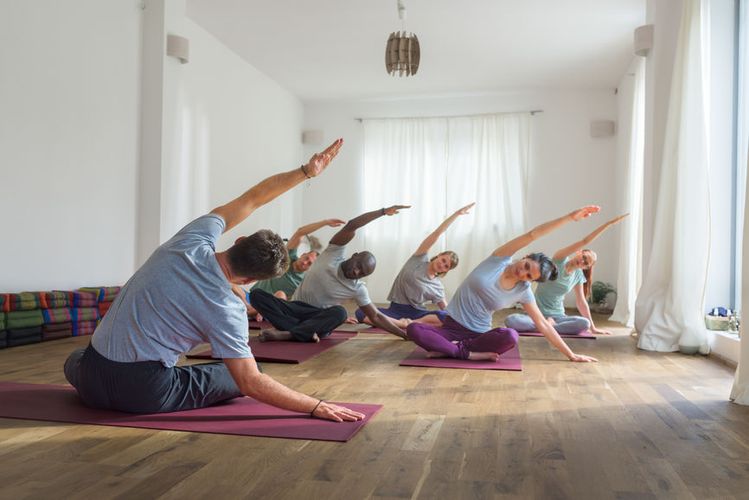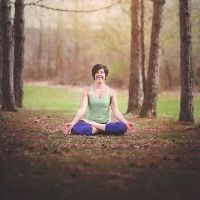Yoga is a family of mind-body practices with roots in the spiritual and religious teachings of ancient India. The word yoga means union, and yoga practice is meant to bring about enlightenment through the union of body and mind. Over the past century, yoga has also become increasingly popular as simply a form of exercise. People all over the world practice yoga in order to improve fitness, support wellness, and build a sense of connection with their bodies.
In its basic form, yoga involves physical poses, breathing, and meditation. Yoga poses are called asanas, and are generally performed in sequence - that is, practitioners do a series of asanas, one after another. The asanas can be anything from simple, gentle stretching to more complex and physically demanding poses that require significant strength and balance to sustain. Yoga practitioners learn to pay attention to their breathing while performing asanas, matching their breath to the motion of their bodies.
There are many different schools or styles of yoga that are practiced today. Most of what we think of as yoga is descended from the Hindu practice of hatha yoga - the physical aspect of the ancient yoga spiritual practice. Hatha yoga was originally meant to tire the body out in order to make it easier to sit still during meditation. The various descendants of hatha yoga practiced today are physically demanding forms of exercise that help develop your body and mind.
While most yoga classes in the United States are entirely secular, yoga still retains a connection to its spiritual origins. For some practitioners, yoga is as much a form of meditation in motion as exercise. Yoga classes also often begin or end with a period of sitting meditation.
Yoga can be a great choice for anyone who wants to get in shape, improve their balance or support their overall wellness. Many people also find yoga is an effective method for working with stress and developing discipline and focus. Yoga can also be a useful practice for people struggling with addiction or other mental health issues like depression and anxiety.
"It's not about touching your toes," says yoga and Ayurveda teacher and lifestyle coach Pleasance Silickii. "People tell me all the time, 'I'm not flexible so I can't do it.' That's not the point. What may happen for some people is increased flexibility. There's also a possibility of increasing balance or strength, in all areas of your life. Being present with your life is the yoga. One of my teachers used to say learn to stand on your feet before you stand on your head. Use your physical experiences on the mat to strengthen your whole life."
How does yoga work?
As a form of exercise, yoga can be practiced alone or in a class with others. Most people choose to attend classes, which are typically an hour to 90 minutes. Classes are led by a teacher, who guides the class through a series of asanas. Some yoga teachers also offer private or in-home instruction.
"Online yoga classes are a phenomenal option as well," says Pleasance. "Monthly subscriptions for unlimited classes are available from Yoga Anytime, YogaGlo, and Yogis Anonymous for the price of a single class, taught by the best teachers from around the world. I suggest you find teachers you like and feel safe with. Online classes can be a terrific motivator to keep going and to establish a consistent practice as part of your life. Yoga is about slow and steady over time."
History and philosophy
The earliest elements of yoga are thousands of years old. Traditionally, yoga is about much more than exercise - it is an entire family of practices meant to facilitate spiritual growth. Yoga has roots in Hinduism, and also influenced and was influenced by other East Asian spiritual traditions.
Indeed, yoga first developed as a branch of Hinduism over three thousand years ago. The physical asanas - hatha yoga - are just one limb of that branch. Other aspects of yoga include meditation, study and philosophy, ritual, service to others, and prayer to the gods. Yoga has been described as both an end and a means to achieve an end.
The core idea of yoga - that mind and body are one and inextricable from the universe as a whole - is a key tenet of Hinduism, as well as Buddhism, and many other religions. The Buddha himself is believed to have studied yoga, and incorporated yoga practices into his teachings. Adherents have traditionally practiced yoga in order to experience that universal oneness for themselves.
The history of yoga in America began in the 19th century. One prominent teacher, Swami Vivekananda, a Hindu monk, made several journeys to the United States between 1893 and 1900. His lectures exposed audiences to yogic teachings and stirred up interest in yoga among American intellectuals.
In the early 20th century Tirumalai Krishnamacharya, an Indian yoga teacher often called the father of modern yoga, helped his students develop several distinct styles of hatha yoga. These styles included Iyengar and Ashtanga yoga, both of which are commonly taught today. Some of Krishnamacharya's students, like the well-known teacher Indra Devi, came to live in the United States.
Americans were quick to embrace the asana focused practices they taught. Yoga fits in with the interest in spirituality, self-discovery and cultural exploration that blossomed during the 1960s. Indeed, yoga maintained popularity even as other elements of that decade's culture waned.
In the last few decades, however, yoga has become mainly seen by Americans and other societies around the world as a form of exercise. While yoga in India is still seen as an essential part of Hinduism, worldwide it is more typically viewed as a wellness practice. Yoga classes are most often just a way to work out, although some teachers still emphasize the spiritual roots of the practice.
Science
While there are different styles of yoga, most affect the body in similar ways. Some of the effects of yoga are similar to those found in most other types of exercise: increased strength, stamina, and metabolism. Others, like improved flexibility and balance, are not exclusive to yoga but are not universal either. One major literature review published in the Journey of Alternative and Complementary Medicine also found that yoga may positively affect blood pressure, respiration, and heart rate.
Research also suggests that yoga can affect the hypothalamic-pituitary-adrenal (HPA) axis and the sympathetic nervous system - elements of the body's stress response. The HPA axis produces stress hormones like cortisol, which can overstimulate the sympathetic nervous system, leading to chronic stress and associated health problems. Yoga has been found to effectively down-regulate the HPA axis and sympathetic nervous system. In other words, it calms the body down. While other forms of exercise also help to reduce stress, studies suggest that yoga is actually more effective at doing so.
Types of Yoga
Almost all yoga classes in the United States are descended from the hatha yoga tradition - the physical, movement-based aspect of yoga. However, within that lineage, there are many different styles or schools of yoga. Some of the most common include:
Ashtanga
One of Krishnamacharya's students was a man named K. Pattabhi Jois. Jois, who developed his own style of yoga that emphasized quick, movement-heavy asanas that practitioners coordinate with their breathing. He saw the asanas and the movements between asanas as equally important. Ashtanga yoga classes typically follow a set, specific series of asanas, performed in order, and are sometimes referred to as power yoga classes. Ashtanga is a good choice for someone who wants to use yoga as an aerobic workout.
Iyengar
Iyengar yoga was developed by B.K.S. Iyengar roughly a century ago. Iyengar also studied with Krishnamacharya. However, in contrast to Jois, when Iyengar began teaching himself, he emphasized maintaining proper alignment - holding and perfecting the structure of asanas - above moving quickly through poses. Iyengar yoga is a slow, deliberate and precise style of yoga that requires practitioners to develop a deep awareness of their own bodies.
Vinyasa
Vinyasa is a popular offshoot of Ashtanga yoga. Like Ashtanga, vinyasa yoga is a vigorous, aerobic style that emphasizes quick movements and breathing. However, vinyasa does not follow a set series of asanas in every class. Instead, teachers are free to lead the class in whatever asanas they choose.
Bikram or Hot Yoga
Bikram yoga is a style of yoga developed by Bikram Choudhury. Bikram yoga is meant to make you sweat. Classes are physically demanding and take place in a hot, humid studio. Bikram yoga teachers always guide the class through a set series of asanas established by Choudhury. Other kinds of yoga classes that also employ a heated classroom are generically termed hot yoga.
Restorative
Restorative yoga classes are meant to help you relax and rejuvenate. Restorative yoga uses poses that don't require any physical exertion to maintain, typically involves stretching and breathing exercises, and is always a low-key, gentle experience. A restorative class is perfect for anyone who wants to get in touch with their body without straining it, or who has any physical limitations or injuries.
Prenatal yoga
Some yoga classes are specifically meant for pregnant women. Prenatal yoga classes are led by teachers trained to adapt regular forms of yoga to the specific needs of expectant mothers. Prenatal yoga classes can help women stay healthy during pregnancy, and recover more quickly afterward.
Yin yoga
Yin yoga is a gentle, calm style of yoga with roots in the Taoist teaching of yin and yang. Yin yoga does not involve strenuous exercise, the asanas are performed seated and are mostly stretching. Instead, yin is about meditating and practicing being present with your body, even if it doesn't have anything to do. Yin is meant to be practiced in combination with more physically vigorous styles of yoga.
Kundalini yoga
Kundalini yoga emphasizes yoga's spiritual aspects. The word kundalini means snake or serpent and it and refers to a powerful, consciousness-raising energy that practitioners teach is coiled at the base of the spine. Kundalini yoga uses breathing, quickly performed asanas and chanting to awaken kundalini energy and channel it up through the body. The experience is said to be profound.
What are the benefits of yoga?
Many people find that yoga can benefit their health and wellness significantly. A regular yoga practice can help you feel better and boost your well-being in a variety of ways. According to the NIH, benefits may include:
- Relief of low back pain
- Relief of neck pain
- Improved control of blood sugar for people suffering from diabetes
- Improved sleep
- Help in quitting smoking
- Help losing weight
- Relief of the symptoms of menopause
- Easing symptoms of anxiety and depression
- Help manage the symptoms of chronic diseases, such as cancer, multiple sclerosis, and chronic obstructive pulmonary disease
Physical
Yoga is a great way to work out. Yoga can help you get stronger, more coordinated, and improve your endurance. Many asanas require good balance, which yoga can help you practice and develop. Long-term yoga practice can also lead to weight loss.
Yoga can also sometimes be beneficial for people dealing with chronic health conditions, such as back pain or inflammation, as well as chronic stress. One study specifically found that Iyengar yoga helped people with back pain experience lower levels of pain and disability. Yoga also improved the mood of people suffering from back pain, and reduce their need for medication. Similarly, long-term yoga practitioners have been found to be less susceptible to stress, and experience less of an inflammatory response as the result of stress.
Mental
Some people find that yoga helps them feel more disciplined, focused and centered. Exercise in any form is good for the brain; it causes the release of beneficial neurochemicals and can lift brain fog, improve mental clarity, and stimulate creativity. Research has also specifically found that exercise involving repeated patterns, like yoga or tai chi, can cause beneficial changes in the structure of the brain.
As yoga can be practiced as a form of meditation in motion, it can share meditation's positive effects on the brain. Many practitioners describe yoga as helping them feel simultaneously more calm and more alert. Why? Yoga can actually shrink the fear center of the brain while enlarging the sections responsible for attention, learning, and memory.
Yoga is treasured as a way of getting us out of our heads and into our bodies. Pleasance shares, "We build up the digestive fire through core exercise in yoga, so our energy begins flowing throughout the body, helping us process stress. So many of us are living in our heads. Many people, when they sit down to meditate, are only spending more time in their heads. Do yoga practice until you're calm enough to sit."
Emotional
Yoga is an effective way of boosting your mood. This can be useful for anyone, but especially helpful for people suffering from conditions like anxiety and depression. Yoga has been found to reduce symptoms of anxiety and depression, and its influence on the structure of the brain can have a positive impact on those who often have difficulty feeling okay.
"The reason yoga is so powerful for all beings," adds Pleasance, "is the integration of mind, body, and soul in a way that very few other practices have. Maybe qigong, but that's really it -nothing else is so integrating. Our physical yoga practice very much helps us digest emotions and the high stress of modern lives, making this ancient practice more important today than ever."
Spiritual
For anyone wishing to develop a deeper spiritual connection with themselves and the universe, yoga is a good way forward. A regular yoga practice can help you get grounded and explore yourself. Yoga's spiritual roots might be left out of most classes, but the basic elements of mindfulness, meditation, and learning to be in your body are there.
Yoga and addiction
Yoga can be a useful adjunct therapy and support for people struggling with addiction to drugs, alcohol, or smoking cigarettes, and is being increasingly taught in addiction treatment centers. Like other forms of exercise, yoga can help stimulate the production of endorphins and other feel-good neurochemicals in the brain. This can help mitigate the pain of drug withdrawal, as well as provide a natural, healthy way of helping people feel good without drugs.
Yoga can also help to alleviate the anxiety, depression, and despair that usually go hand-in-hand with addiction. Both the asanas and the breathing exercises that go along with them can help to calm the body and relax the mind. Yoga's spiritual depth can also provide a path for someone looking to get free from addiction.
Safety and side effects
Yoga has typically no significant side effects other than soreness or tiredness after a class and is generally safe for people healthy enough for physical exercise. However, some yoga poses can lead to strain or injury if performed by an inexperienced practitioner. It is suggested that you study yoga with an experienced, certified teacher who can ensure that you practice the style and level of yoga that is right for you. In addition, hot yoga or Bikram classes can lead to dehydration unless you drink plenty of water during and after class.
For people with physical limitations, injuries, or who might otherwise not be capable of vigorous exercise, yoga can still be a great fit. Restorative yoga classes in particular often involve only simple stretching and breathing exercises that anyone can do. Most yoga teachers can also design a yoga routine that fits with your specific physical needs.
If you have any health conditions, experts recommend checking with your doctor and discussing your specific health conditions with your yoga teacher before beginning a yoga practice.
References:
1Alyson Ross and Sue Thomas.The Journal of Alternative and Complementary Medicine.Jan 2010. Published in Volume: 16 Issue 1: January 27, 2010
2James A. Raub.The Journal of Alternative and Complementary Medicine Dec 2002 http://doi.org/10.1089/10755530260511810
3Yoga: In Depth. (2018, November 08). Retrieved December 20, 2018 https://nccih.nih.gov/health/yoga/introduction.htm













